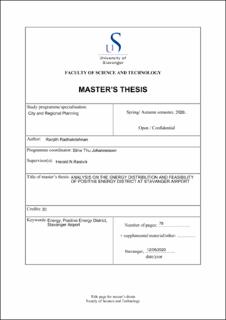| dc.description.abstract | Airport's primary role is to provide passengers and freight connections to air travel. Over the past 20 years, the number of air operations has increased rapidly, leading to increased airport energy needs to meet this demand. Consequently, airports' energy procurement prices have risen. Around the same time, world energy demand has been increased because of the requirements of developing countries with the resulting impact on the climate. Airport authorities incur a tremendous amount of energy bills. This dynamic environmental and economic impact scenario has made airport authorities aware of the need to minimize energy usage and use it more effectively. But sadly, irrespective of the energy that they use or the amount of CO2 that they emit, it is unaccountable. Moreover, all airports, including Sola Airport, are dependent on the electricity generated from conventional energy sources such as coal, natural gas, hydropower, etc. Thus, right from the time of its construction, airports cause environmental pollution (Ko, Jang, & Kim, 2017). The PV installation may be an initiation of something that can inspire other institutions and government and non-government buildings to install PV panels and obtain clean energy from solar power. Besides, only the landscape on which the panels are used to harvest energy differs. Once the energy is harvested, the panels can be used elsewhere (Sreenath Sukumaran a, 2017). This research paper analyses the energy distribution, consumption, and demand at Sola Airport. It discusses the various energy scenarios, along with different energy harvesting possibilities and techniques that could be well adapted at the airport. Energy mapping and management play a vital role in understanding energy usage and the conservation of energy by various means of regulations and practices. Energy scenarios and simulations were made in accordance to compare future energy needs following the functions of PED. The energy demand from both electricity and heating is considered when we evaluate a system to be a PED. But in this specific case, only the direct electricity demand is considered as the heating, and cooling needs are taken care of by wood and waste burning facility that is situated near the airport. Some claims have been found that there have been a savings of 2000 tons of CO2 equivalent is being saved by this process. This report also discusses the same. Battery technology, electricity credits, and electrification of Airplanes were studied in the latter half of the report. | en_US |
